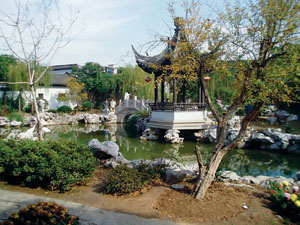
Among the growing number of water towns that entice tourists to the heart of their historic byways, Mudu may not be the biggest or the richest in historic treasures. It is, however, a pleasant destination for day-trippers, especially those who aren't up for the rigors of Suzhou sightseeing.
We were invited to accompany a tour from Shanghai made up of employees who worked in medical-related jobs. Our invitation was designed to give group members the opportunity to speak English throughout the day and possibly improve their skills. It was not the easiest way to practice English, but several members of the group were eager to try.
Mudu is a small city that dates back to the Ming Dynasty (1368-1644). Built at the foot of Lingyan Hill in the western suburbs of Suzhou, the city once included more than 30 private gardens where wealthy officials, revered intellectuals and artists enjoyed the peace and ambience of canalside living. Its claim to fame is touted on a sign near the entrance to the old town: Emperor Qianlong of Qing Dynasty (1644-1911) visited six times.
Four of the ancient dwellings have been restored along the main canal and offer a glimpse of the scale and opulence of life enjoyed by the fortunate during the Ming and Qing dynasties. All four are within walking distance of the town gate, and although they are similar in design each has its special aspects.
Hongyin Mountain House is the attraction that brought Qianlong back so often. It is huge by any standard of architecture from the period. The estate is actually the combination of the former Xiuye Garden and the Xiaoying Garden, which was once home to Shen Shou, then known as the embroidery princess south of the Yangtze Delta.
The huge courtyard just inside the entrance was where Qianlong sat to watch Peking operas on the stage above. Scaled down versions of opera are presented karaoke style throughout the day, so most visitors have a chance to observe the ancient entertainment before setting out on a tour of the extensive house and gardens.
Yan's Garden is perhaps the most attractive scenic delight among the four houses. The garden is centred upon a lake that meanders through the grounds. It is lined with trees and its amazing ornamental West Lake Rockery that is unlike any other decorative rockery in the world. Former home to Yan Jiagan, who hailed from China's Taiwan Province, Yan's Garden was designed in the classic style on its one-plus hectare setting by Liu Dunzhen, perhaps the most famous architect of his time. A large magnolia tree in the garden was reputedly planted by Emperor Qianlong during one of his many visits to the area.
It's easy to see that the old mansions were built along the same lines, so once you've seen a couple of them your attention may wander. The real treasures are the gardens, where imagination and creativity were given free rein. It is hard to imagine now the scope of thoughtfulness and precision that went into their design, and each one is worth a look.
The canal does not add much charm to the surroundings. No boats ply the exceptionally dirty water and vendors along the way offer much the same in the way of tourist gewgaws as found in any tourist area, except maybe on a smaller scale. There are several teahouses and eating establishments which appear interesting but on the whole offer nothing to write home about.
(Shanghai Star January 8, 2005)
|

